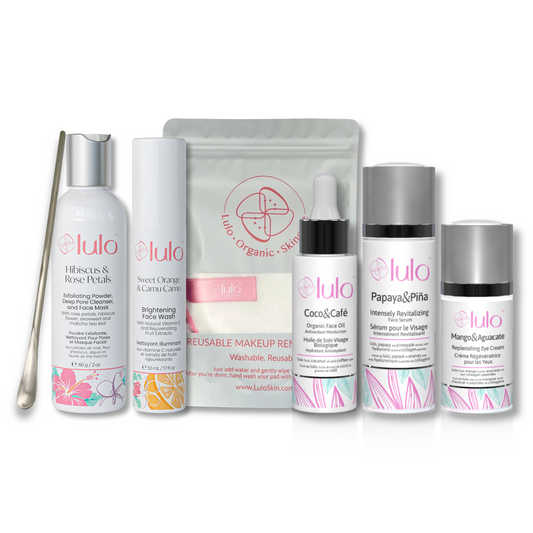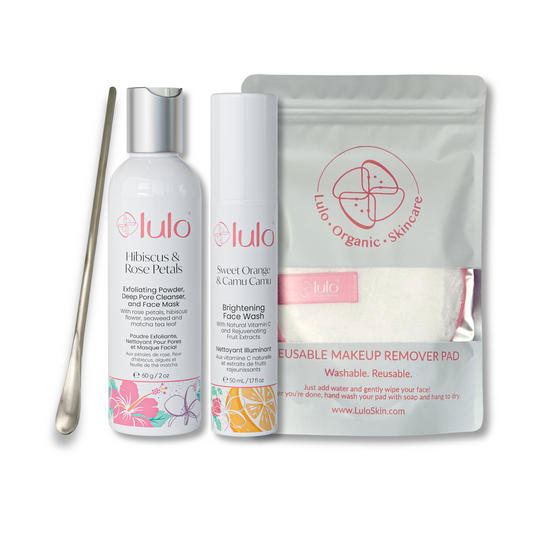
What Are The Best Anti Aging Ingredients?
The skincare and personal care worlds are plagued with buzzwords, terms and ingredients that are widely used… and widely misunderstood.
Most of us have purchased a product because it contains an ingredient that, if we try to explain, we discover that we have no idea what it really is or if we should actually be putting it on our bodies.
However, some of those terms are more than just buzzwords and are key ingredients that are beneficial for our skin and support some of the most common skincare concerns. Read on to discover three of those terms and equip yourself to decide if they should be part of your routine:
- Hyaluronic Acid
- Peptides
- Antioxidants
1. Hyaluronic Acid
This is one of the most misinterpreted and beneficial ingredients out there! First, the name is misleading… it's not an "acid" but rather a gooey substance that is naturally produced by your body to retain water and keep your skin moist and your joints lubricated.
You may have seen it as "HA" and heard of it in diverse, seemingly unrelated contexts. This is because it is used in numerous ways. For example, it can be injected into arthritic joints to re-lubricate them, injected into facial wrinkles to fill and plump them cosmetically, and applied topically in skincare to attract and retain water giving the skin a moisture boost.
Its unique capacity to bind and retain 1,000 times its weight in water is the reason why it is so sought after in the skincare industry. The additional hydration gives your skin a plumping effect and reduces the appearance of wrinkles.
Also, when applied to the surface of the skin, hyaluronic acid serums can reduce redness and dermatitis. [1]
Hyaluronic acid can enhance moisture content beyond comparison. It also revitalizes skin’s outer surface layers, so they look and feel softer, smoother and hydrated.
At Lulo Skin, we use “low molecular weight” hyaluronic acid, which has a smaller molecule than regular hyaluronic acid. Molecules of “regular” hyaluronic acid are larger and tend to remain on the skin’s surface. Making hyaluronic acid smaller means it can reach deeper layers of the skin for better results.
How to Use Hyaluronic Acid For Skincare
Hyaluronic acid is gentle enough to be used daily and by all skin types, even the most sensitive. It has a calming effect, and it’s also suitable for breakout-prone skin. Lulo's Revitalizing Face Serum - Papaya & Piña contains high doses of hyaluronic acid. Its lightweight texture makes it perfect for daily use and for all skin types.
This serum is indispensable for dry skin, and for those looking for a healthy glow. It smooths the look of fine lines and wrinkles and replenishes moisture. Also, thanks to its mix of papaya and pineapple, it improves skin’s complexion, helps reduce pigmentation, and makes an effective, non-abrasive exfoliant.
It's also important to note that our Revitalizing Face Serum also contains Vitamin C and not all Vitamin C is manufactured the same. We don't use ascorbic acid; we use Vitamin C derived from the cellular walls of the Lulo fruit. Natural vitamin C also contains additional phytonutrients that are beneficial for the skin. Synthetic vitamin C, like ascorbic acid, is made in the lab and usually from ingredients like corn syrup and processed with chemicals like acetone, yes… acetone as in chemical nail polish remover… Yikes!
2. Peptides
It's hard to explain what a peptide is without getting into scientific terms, but simply put, peptides are made up of amino acids, which are the building blocks of proteins.
In skincare, peptides are used to help reinforce proteins that are naturally occurring in the skin, they help rebuild and maintain proteins like collagen, elastin, and keratin. Different peptides have different effects, from smoothing wrinkles to repairing skin's texture, tone, and firmness.
How to Incorporate Peptides into Your Skincare Routine?
There are thousands of studies that show that peptides can target specific skin concerns; they help revive aging skin and improve texture, the appearance of wrinkles and the loss of firmness.
When peptides are blended with antioxidants, skin-soothing ingredients, and skin-replenishing ingredients, they can address multiple signs of aging. That's what you can get with Lulo's Replenishing Eye Cream - Mango & Aguacate. Its collagen peptides target loss of firmness and wrinkles. It is specially formulated to replenish nutrients and penetrate the delicate skin around the eyes with avocado seed oil's powerful antioxidants and anti-inflammatory properties.
The skin around the eyes tends to be the first to lose tightness and show fine lines; the mango seed butter in Lulo's Replenishing Eye Cream - Mango & Aguacate target both conditions by moisturizing, tightening, and conditioning this skin.
3. Antioxidants
This is one category of skin care ingredients you can never have too much of! Antioxidants defend your skin against pollution and environmental damage and work in the deep layers of the skin to improve its texture.
An antioxidant is a molecule that stops the oxidation of other molecules. Oxidation is a chemical reaction that produces free radicals and leads to cell damage and premature aging.
The most noteworthy benefits of antioxidants are:
- Defend your skin from pollution, which can lead to sagging, wrinkles and dullness.
- Provide a brighter complexion: Some antioxidants, like vitamin C, have the unique ability to improve the appearance of dull, uneven skin tone and deliver a more healthy-looking complexion.
- Sooth the skin: In particular, green tea and chamomile stand out for their distinct calming effects to visibly soothe redness.
- Fight wrinkles: antioxidants help diminish and visibly soften the appearance of wrinkles.
How to Incorporate Antioxidants into Your Skincare Routine?
There are a large number of antioxidant-rich sources so it’s no wonder that you see this word everywhere. Some of the top sources are coffee, aloe, green tea, vitamin A, vitamin C, vitamin E, just to name a few.
While you will read that Vitamin C is a must have in your skin care routine, you should not omit the other powerful antioxidants as there is not a single one that combats all free radicals by themselves.
There isn't a singular “best” antioxidant that you need to look for—what counts is that the product you use contains a variety of antioxidants (the more, the better).
To get those benefits, you can eat fruits and vegetables rich in antioxidants, or you can also apply products with a high content of antioxidant ingredients, like Lulo's Vitamin C Face Oil - Coco & Cafe.
This oil is packed with skin-loving nutrients like coffee seed extract, avocado oil, coconut oil, lulo fruit extract, sunflower seed oil, and hibiscus flower extract. All of them highly antioxidant and conditioning. These ingredients penetrate deeply to lock in moisture and increase elasticity, diminish the appearance of wrinkles, and decrease the appearance of sun damage and discolouration.
[1]The Journal of Clinical and Aesthetic Dermatology. 2014 Mar; 7(3): 27–29.





1 comment
This is great advice. Hopefully, I will be able to purchase your wonderful products.